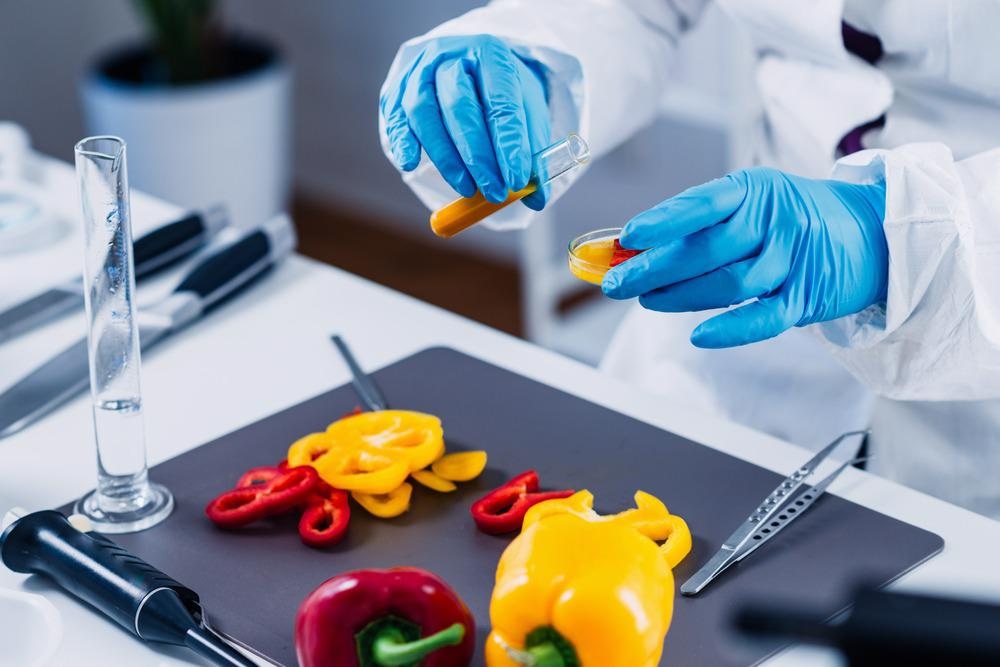Food additives are substances that are added to food products for a variety of purposes. For example, they can serve to improve or maintain the safety, freshness, taste, texture, or appearance of foods. More specifically, many of these food additives are used to control the pH, viscosity, stability, and homogeneity of food products, all of which are biological functions that contribute to the overall shelf life of food products, while maintaining their safety for human consumption.

Image Credit: Microgen/Shutterstock.com
Since the Food Additive Amendment was added to the Food, Drug, and Cosmetic Act (FDCA) in 1958, the United States Food and Drug Administration (FDA) has been granted the authority to determine whether food additives are safe before they are introduced into commercial food products.
In addition to direct food additives, such as those that are incorporated into food products for a specific purpose, indirect food additives are also monitored by the FDA. An indirect food additive is any substance that is introduced into the food product through agricultural or packaging processes. Some examples of indirect food additives can include pesticides, drugs that are used in the management of animals, as well as substances that migrate from food contact surfaces (FCSs) and packaging.
Important Considerations for Analysis
Several studies have found that the cumulative consumption of food additives can increase the likelihood of consumers developing allergies, diabetes, obesity, and metabolic disorders. Some food additives have been associated with a wide range of toxic effects that have caused regulatory bodies such as the European Food Safety Authority (EFSA) to completely ban the use of these food additives altogether.
There are several analytical techniques that are available for the identification and quantification of food additives that are present in a wide range of foods, including feedstocks, independent ingredients, processed products, and end-products.
Since food products can potentially consist of fats, lipids, proteins, carbohydrates, polysaccharides, salts, surfactants, pigments, emulsions, and other compounds that could interfere with the analysis, they must undergo analysis both at the time of sampling as well as throughout the pre-treatment steps that are needed to prepare the sample for analysis.
There are several analytical techniques that are available for food additive analysis, most of which can be classified as either spectroscopic, chromatographic, or electroanalytical. The choice for a given analytical technique will often depend on whether the sample is in a liquid, solid or gas state, the expected additive level present within the sample, the availability of specific equipment and reagents, the number of samples, the expertise of the analyst, as well as the presence of any interfering substances.
Spectroscopic Methods for Food Additive Analysis
The basic principle of all spectroscopic techniques is the analysis of the interaction between electromagnetic radiation, which is typically provided by an electromagnetic beam, and the sample.
The energy generated from heat, electric discharge, or light excites the electrons into a greater state of energy, whereas the fundamental state of electrons will arise after the electrons return to their initial energy status, thereby releasing energy that was previously absorbed.
The chemical structures of food additives have distinct functional groups that enable spectroscopic techniques to measure the absorption and emission of electromagnetic radiation at specific wavelengths.
Mannitol, sucralose, and mineral oil are common food additives that can be detected through spectroscopy techniques. Whereas mannitol is often detected in fermented rice products, mineral oil can typically be detected in dry pasta, bread, biscuits, and plum cakes.
Some of the most common spectroscopic methods that are used by food industries to quantify the presence of food additives in their final food products include ultraviolet/visible (UV/Vis) spectroscopy and infrared (IR) spectroscopy. Both of these techniques can provide important information on the chemical composition, textural characteristics, and quality-related parameters of food additives.
UV/Vis Spectroscopy
UV/Vis spectroscopy can analyze samples that are within the wavelength range of 190 to 800 nanometers. A typical UV/Vis system will consist of an electromagnetic radiation source, a method to select the wavelength to measure the transmittance, as well as a detector.
This low-cost approach is efficient and eliminates the need for sample destruction. However, it is associated with certain limitations, including undesirable selectivity as a result of other chemical compounds within the food product that can also absorb electromagnetic radiation.
IR Spectroscopy
The basic working principle of IR spectroscopy is that light is absorbed by the chemical compounds within a sample, which subsequently alters their vibrational energy levels to enable different functional groups to absorb various frequencies of IR radiation.
Notably, IR spectroscopy identifies the chemical functional groups present in solid, liquid, and gaseous samples.
Near IR (NIR) spectroscopy is commonly used to analyze feedstocks and final food products for the presence of food additives. Some of the most common food products that will be analyzed through this approach include biscuits, muesli bars, ready-to-eat breakfast products, processed meat products, as well as butter and margarine.
Other Spectroscopy Methods
Although UV/Vis and IR spectroscopy are most commonly employed for food additive analysis, several other spectroscopy approaches can also be used, such as Raman spectroscopy and Fluorescence spectroscopy.
References and Further Reading
Food additives [Online]. World Health Organization. Available from: https://www.who.int/news-room/fact-sheets/detail/food-additives.
Pressman, P., Clemens, R., Hayes, W., et al. (2017) Food additive safety: A review of toxicologic and regulatory issues. Toxicology Research and Application. doi:10.1177/2397847317723572.
Martins, F. C. O. L., Sentanin, M. A., De Souza, D. (2019) Analytical methods in food additives determination: Compounds with functional applications. Food Chemistry 272; 732-750. doi:10.1016/j.foodchem.2018.08.060.
Disclaimer: The views expressed here are those of the author expressed in their private capacity and do not necessarily represent the views of AZoM.com Limited T/A AZoNetwork the owner and operator of this website. This disclaimer forms part of the Terms and conditions of use of this website.